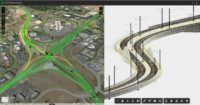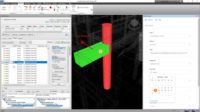Autodesk is adding three new products—Autodesk Build, Autodesk Quantify and Autodesk BIM Collaborate—to its construction cloud offerings and also launched the digital twin management tool Autodesk Tandem.
The new products were announced this week at the software vendor's Autodesk University (AU) conference, held entirely virtually for the first time due to the COVID-19 pandemic. The company also announced the acquisition of AI-enabled generative design tool Spacemaker, as well as a partnership for electrical design with electrical power systems manufacturer Schneider Electric.
Autodesk Build is an amalgam of the features and functionality of BIM 360 and PlanGrid designed for field and project management, the company said in a statement. It was built off of the technology undergirding the PlanGrid Build mobile app, with new capabilities including RFI creation and more drawing markup options.
Autodesk said Autodesk Quantify will allow construction estimators to perform quantity take-offs from both 2D plans and 3D models on a unified platform. Autodesk BIM Collaborate was created to help building teams "align and execute on design intent by managing the entire design collaboration and coordination workflow from a single solution," Autodesk said in its press release. It added that Quantify does this through a unified project timeline, aggregated model viewing and a change review component.
"We were very clear that our product priorities were around continuing to build out capabilities of the existing portfolio," says Jim Lynch, vice president and general manager of Autodesk Construction Solutions. "BIM 360, Plangrid, Assemble, of course now Pype and BuildingConnected. The second thing we said we were going to do was build point-to-point integration between those products, and we've done that. This is all leading up to a unified platform and portfolio."
Autodesk's pursuit of a more connected construction cloud that customers can use for all phases of any project has been a point of emphasis since President and CEO Andrew Anagnost took the helm in 2017. The company had previously kept a more clear separation between its manufacturing, media and architecture, and engineering and construction products.
“Our vision of construction is nothing less than to connect everything from the conceptual model to the final handover and everything in between," Anagnost said at a Zoom press conference at AU. "What you’ll also see is a continued focus on where money gets committed. You can see how we’ve taken from every piece of technology we’ve ever built and put it into this new offering."
Autodesk said last year that that focus on construction delayed investments in design software, including its Revit BIM platform and promised more investment in design as a result of a letter demanding more development from 119 architects. The company pointed to the acquisition of Spacemaker, a tool that uses artificial intelligence for generative designs of buildings and urban spaces, as a step toward letting users automate laborious processes. Anagnost also promised further generative design natively within Revit beyond the features introduced earlier this year.
The Schneider Electric partnership is intended to fill another granular gap in design-to-construction workflows. Schneider and Autodesk have agreed to co-develop a cloud-based service for electrical designers using Autodesk Forge, the company's developer platform. The goal is to build a service that will offer engineers electrical design capabilities including load distribution mapping, power balancing, equipment sizing, and single-line diagramming.
“Rather than spending countless hours designing a network from scratch, with the new solution, electrical engineers will incorporate ‘lessons learned’ from previous work to create more impressive new projects,” said Marc Nezet, senior vice president of Energy Management Software at Schneider Electric.
Anagnost said that as Autodesk enables more sharing of data from other manufacturers and its own data on its construction cloud, this type of partnership will become more common.
"It’s not about the file format anymore… it’s really more about a sub-element level of data," he said. "What’s more important is data application program interfaces [APIs]. Given the digitization of all of these industries, you will see more partnerships using APIs and open APIs and I would fully expect to see more partnerships like that [Schneider Electric partnership] in the future."
But the company is not shying away from using its BIM authoring tools and expertise to offer products for owners. Autodesk Tandem, the digital twin product announced at AU, was created to allow project teams to unify all 3D models used on a project into one digital twin that can then be repurposed for operations and maintenance.
"[Autodesk Tandem] is a purpose-built tool that gives owners and operators greater insight into their completed project, so that they can make informed decisions to improve performance," said Nicolas Mangon, vice president of AEC business strategy. Autodesk became a founding member of the Digital Twin Consortium in October.






Post a comment to this article
Report Abusive Comment